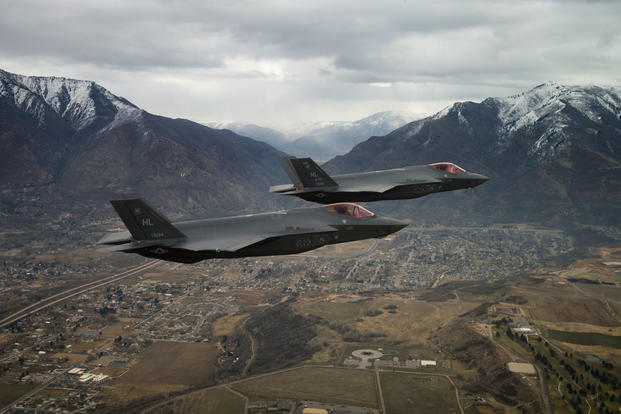FARNBOROUGH, England -- The U.S. Defense Department on Monday rejected a rumor that F-35 aircraft standing by at Naval Air Station Patuxent River in Maryland were set to leave Tuesday to make their international debut at the Farnborough International Airshow.
Officials here at the show and at the Pentagon quickly rejected the report, which emanated from a post on Pax River's official Facebook page. They reiterated that they couldn't say when -- or even whether -- the next-generation stealth fighters will be able to fly to the United Kingdom as planned.
The Pax River page last week published a seemingly innocuous photo and caption of the four F-35B jump-jet variants waiting for authorization to travel to the show. The entire F-35 fleet has been grounded since July 3 following a June 23 engine fire aboard an F-35A conventional model at Eglin Air Force Base in Florida. On Sunday, someone -- presumably a public affairs representative --added a comment beneath the photo, "Slated to leave Tuesday morning."
That set off media speculation that the F-35Bs, including three Marine Corps and one Royal Air Force aircraft, would arrive at Farnborough late Tuesday in time for an appearance at the event on Wednesday. (The roughly 7-hour transatlantic trip itself would be a milestone, as the longest flight recorded by any F-35 stands at 5.8 hours.)
During a press conference at the show on Monday, questions about the post drew blank stares from Pentagon officials, who clearly hadn't seen or heard of it and reiterated that while they remain hopeful the jets will be able to make an appearance by the end of the show, no decision had been made yet to clear them to fly.
Air Force Lt. Gen. Christopher Bogdan said the planes continue to sit perched on the flight line, in effect on a 24-hour alert.
"The minute they are cleared, they will launch," he said.
Col. Steve Warren, a spokesman at the Pentagon, said the post has since been taken down.
"We made no such announcement," he said.
Indeed, the post was later changed to state, "UPDATE: It is unknown when the four F-35B aircraft from VMFA-121 Green Knights will be authorized to fly. If they can arrive in the UK with sufficient time to support the FIA airshow, they will do so."
VMFA refers to Marine Fighter Attack Squadron 121, the Yuma, Arizona-based Marine Corps unit that operates the aircraft.
The F-35Bs were scheduled to attend multiple events this month in the United Kingdom as part of their first public appearances abroad. The events included a fly-over on July 4 at Rosyth Dockyard, Scotland, as part of a naming ceremony for the new British aircraft carrier, the HMS Queen Elizabeth; a static display last week at the Royal International Air Tattoo at Royal Air Force Fairford; and an aerial demonstration this week at Farnborough.
The appearances were designed in part to send a message to international partners and potential buyers that the single-engine fighter has rounded the corner in terms of development. The program, which began development in the 1990s, has been plagued by design challenges, cost overruns and schedule delays.
The Joint Strike Fighter, as it’s officially known, is the Pentagon’s most expensive acquisition program, estimated to cost nearly $400 billion for 2,443 aircraft. Keeping the planes flying over the next half-century may cost another $1 trillion in sustainment.
Eight countries have committed to help develop the F-35, including the U.K., Italy, the Netherlands, Turkey, Canada, Australia, Denmark and Norway. Also, Israel, Japan and South Korea plan to buy production models of the aircraft.
-- Associate Editor Richard Sisk contributed to this report.









